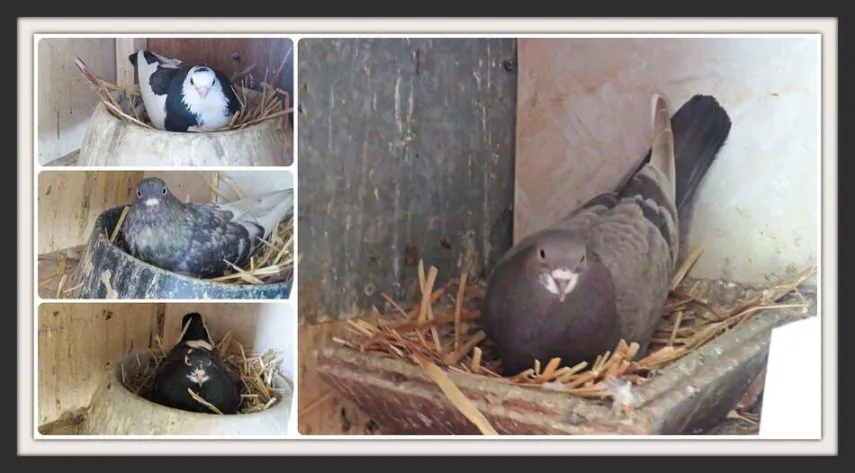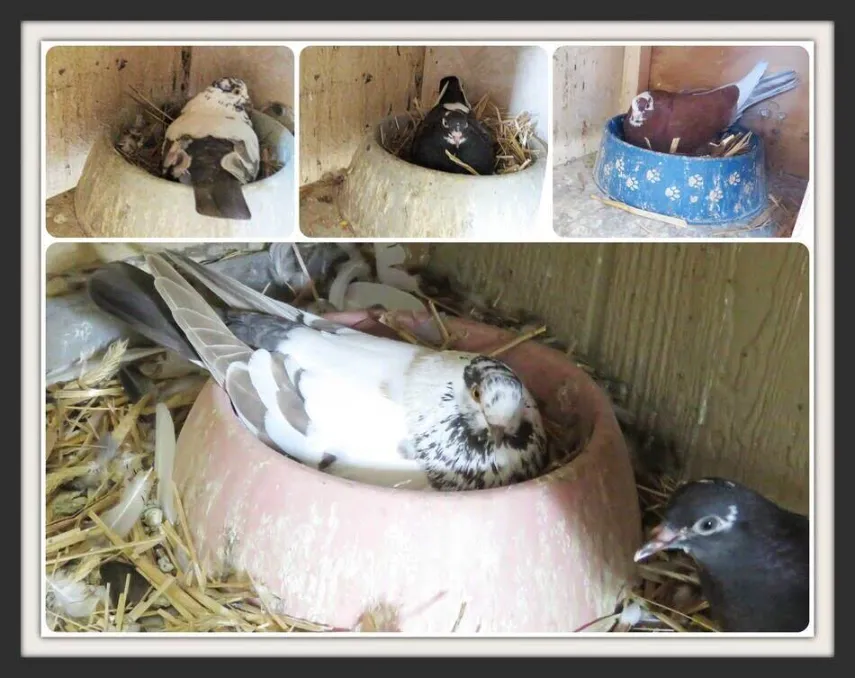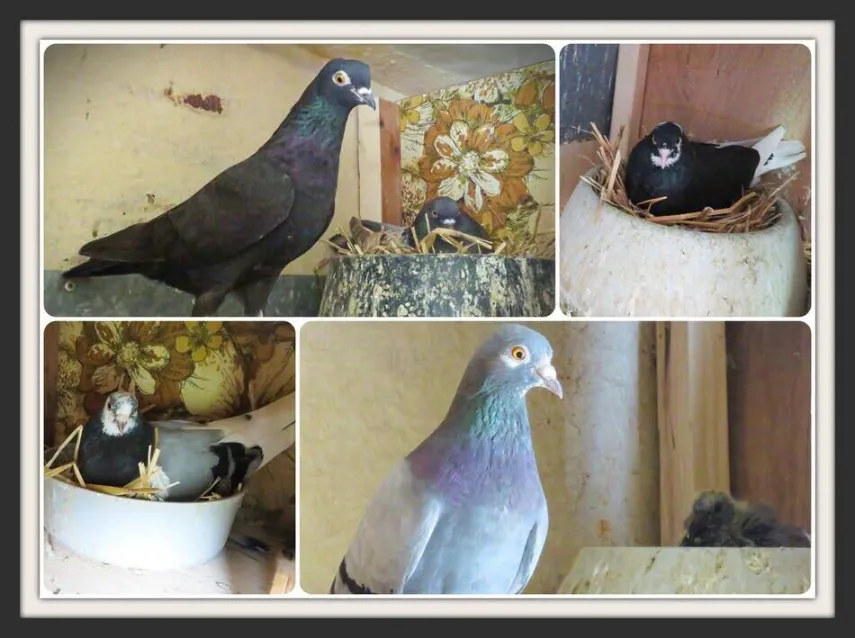We have a fairly complex breeding program, but for the purposes of this article, I will walk you through a simplified overview of our initial setup. So, while we will not be going into precise detail in this article, I feel fairly confident you will learn new things just the same.
Here’s A Short List Of Topics We’ll Cover Here:
- Do we separate our birds by sexes during the off-season?
- When do we pair them up and give them nest bowls?
- What type of nest bowls do we use?
- How do we keep babies healthy while they grow?
Off Season:
We do not separate our sexes during the off-season; in fact, our breeders live together in the breeder loft all year. We do not fly our breeders, as we are very careful not to lose any. We have really large fly pens, so they will always have all the benefits of being outside. We carefully select our breeders to ensure we continue breeding new variations of uniquely colored babies while at the same time pairing up breeders according to how the previous babies performed when flown. This helps us determine which birds we want to breed together. We learn from our own personal experiences through trial and error. So, in the end, we do what works best for our birds.
Now, I am well aware most roller guys/gals separate their sexes during off season and if you are one of them and that method works for you, Great, keep doing that. We, on the other hand just chose to do things a little different and it’s been working in our favor. I am not saying our methodology will work for everyone, I am merely sharing how we do things. I hope you find some useful takeaways in this article. So, keep reading…

Pairing Breeders:
As with many of you, the breeding season is heavily reliant on the spring weather. I like to set up my loft by putting nest bowls out at the absolute earliest possible date, Feb. 14th, but usually won’t start the process until around April 14th. Why do I wait so long, you ask? Well, in a nutshell, I don’t want week-old babies in the nest when it’s still cold. This can inadvertently stunt the growth and health of the babies and prevent them from ever reaching their full potential. Have you ever bought birds from somewhere and wondered why they just never really fly much? What conditions were those babies raised in? All valid questions that most people do not know or think to ask before purchasing. Here, we are steadfast in our belief that the birds’ well-being matters above all.
Nest Bowls and Loft Conditions:
Nest Bowls: Our nest bowls are made of wood (I’m pretty handy and made my own) and offer plenty of room for birds. When I didn’t have enough, I purchased a stack of plastic dog food bowls at the store. I then cut boat carpeting into a circular shape and glued it inside the bottom of each bowl. It is very important to not allow any slippery surface in bowls so babies’ legs don’t develop deformities from sliding out from under them. The straw will then be cut up with scissors and placed inside each nest bowl. I will change out the straw every day or every other day, depending on how fast they poop it up. Babies should never be left sitting in their own filth.
Loft Conditions: Our lofts are Fully insulated (roof, floor, walls, windows, and doors in winter). I also installed electricity inside every coop as well, so my birds have lights, heat lamps in the winter, and fans blowing in the summer. Let me just add that, if you are able to, I highly recommend running electric to your coops and lofts. It really is the best thing I ever did. It sure beats having to stretch extension cords all over the yard. Can I also just say how much my birds absolutely love not sitting in the dark in the winter for 12–15 hours a day, being warm with heat lamps, and feeling cool all summer long with fans blowing and circulating the air inside when it’s hot. I actually find my birds are healthier during the winter when I leave a light on all night so they can freely move around and not just sit in one spot in the cold, dark night shivering to stay warm. Before you say it, the answer is yes; all animals get cold in the winter. Wild pigeons only live a few years at best because of the weather conditions they have to endure.
Pairing and Breeding:
The Pairing Process: When the snow melts and the weather warms, the cocks begin courting and driving the hens to their nest box. My birds normally won’t nest until I put out nest bowls with straw in each nest box. I am very diligent about making sure all nest bowls are put out on the same day to ensure our pairs all lay eggs at the same time. Therefore, we will have groups of young all the same age to wean into kits for training and flying.
Force Breeding: This is necessary if you find a breeding pair that is giving you crashers or babies that don’t really do much when flown. At this point, we will go back to the parents and break them up. Some people don’t realize that pigeons mate for life, so forced breeding is a must to get them to accept a different mate. At this point, we will lock the new pair we want in a nest box together. Now, this can take some time to get them to accept each other and be mated going forward. I will feed and water them in that nest box (my nest boxes are large enough to have two nest bowls comfortably in one box at the same time). This could take several days to a week. Then I will let them out, and they will remain a mated pair from then onward. However, there are some tricky ones who are dead set on returning to their old mate, so in this situation, a bit more finesse is required. I’d have to remove the birds I’m forcing to pair out of the loft and put them in a cage in my garage. The purpose of this is to keep them from seeing their old mate in the loft. Now, this process could take up to a week or more before they finally accept each other. When he coos on his new hen, it’s a good sign that you can return them to the loft, but keep them locked in their new nest box for a day or two so they know which one is theirs. Then let them out freely in the loft and watch for confirmation that the process has proven successful.
Egg Laying Process: A pigeon cock will breed his hen, usually in the fly pen, as he needs plenty of room to breed her. Then, in approximately 10 days, she will lay eggs (two eggs). She will sit for 19 days (male and female take turns sitting), after which the eggs will hatch. Both parents regurgitate rich “milk” and feed their babies for roughly 4-5 days. After which, the parents will regurgitate seeds and grains to feed their babies until they are ready to be weaned. This is why the feed you give your breeders matters. A constant supply of fresh, cool, clean water is required. Parents like to pump their babies with quite a bit of water in the summer, which keeps babies cool in their nest bowl. Food must be nutritious and have protein in order for babies to grow fast and heavy. (Here is my article on Feed.)

IN CONCLUSION:
So, in a nutshell, that’s the basics of breeding. I just wanted to give you a quick overview and keep this article short and easy to follow. Like I mentioned in the beginning, our husbandry program and calendar tracking plus flying, weening, and re-pairing get pretty intricate, so just start out with the basics and find your way from there. Don’t forget to band your babies on time, and in the hot summer months, keep a close eye on the nest bowls and check parents and babies for any sign of bird mites. If you find any, you can use the blue can of Raid Flying Insect Spray under the wings. This will kill mites on contact. Humidity attracts mites, which is unavoidable at times, so be vigilant and keep nest bowls and lofts clean at all times. That’s all for now; drop us a line if you have any questions.


